| “ | Kill me Wayne, You won't do it! | ” |
— Corll's last words
| ||
Dean Arnold Corll, a.k.a. "The Candy Man" or "The Pied Piper", was an American ephebophilic and hebephilic serial killer, serial rapist, and abductor who perpetrated the so-called Houston Mass Murders, which at the time of its discovery, were considered the worst example of serial murder in the history of the United States. Most of Corll's victims were procured for him by two teenage accomplices, David Brooks and Elmer Wayne Henley, the latter of whom later became Corll's killer.
Background[]
Corll was born in Fort Wayne, Indiana, on December 24, 1939. He was the first child of Arnold Edwin Corll and Mary Robinson. Corll's parents had frequent arguments and they divorced when he was seven. That same year, he was diagnosed with rheumatic fever and had to forego physical education. The combined effect of growing up in a broken home with medical difficulties made him a shy boy who rarely socialized with other children, though he still cared for the well-being and feelings of others. In 1950, Corll's parents attempted reconciliation and even married again, but they divorced for a second time three years later. Corll's mother, who had retained custody over Corll and his younger brother Stanley, remarried to a traveling clock salesman named Jake West and had a third child with him.
The family later settled in Vidor, Texas where they opened a candy-making business named Pecan Price. While they were in high school, Corll and Stanley ran the candy-making machine and packed the product while West sold it. The working hours did not bother Corll, who was noted to be a well-behaved student with satisfactory grades. However, he continued to be regarded as a loner by his peers, although he would date girls occasionally. Following Corll's graduation in the summer of 1958, the family moved to Houston, where they sold most of their products, and they opened their own Pecan Price shop. Two years later, Corll obeyed his mother's request to return to Indiana and live with his widowed grandmother. There, he dated a local girl; at some point, she proposed to him, but he turned her down.
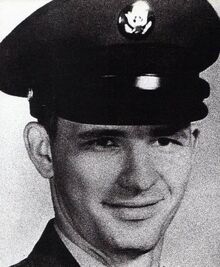
Corll during his time in the U.S. Army.
The West-Robinson marriage began to face difficulties in 1962. Corll returned to Houston to help them, but in 1963, the marriage fell apart and they divorced. Robinson opened her own candy business and made Corll vice-president. That same year, one of Robinson's teenage male employees complained about Corll making sexual advances towards him, but she simply fired the boy. A year later, Corll was drafted into the U.S. Army and was assigned to Fort Polk, Louisiana, for a ten-month training regime. There, Corll realized that he was homosexual, and he had his first sexual relations. After being honorably discharged, he returned to work in his mother's company and made advances towards male employees. In 1967, Corll met twelve-year-old David Owen Brooks, and the two became close friends. They would go on trips together, and Brooks admired Corll to the point of considering him a substitute father. However, the relationship took a darker turn beginning in 1969, when Corll paid Brooks to perform oral sex on him. After the closure of the candy company, Corll got another job testing electrical relay systems at the Houston Lighting and Power Company.
The Houston Mass Murders[]
Corll's first known murder victim was Jeffrey Konen, a student at the University of Texas in Austin, whom he abducted while hitchhiking on September 25, 1970. Konen's body was later buried in High Island Beach. Around the time of Konen's murder, Brooks interrupted Corll in the act of raping two teenage boys, whom he strapped to a torture board. Corll promised Brooks a car in return for his silence and he accepted the offer. Shortly after murdering the boys, Corll bought Brooks a green Chevrolet Corvette. Later, Corll offered $200 to Brooks for any boy he could lure to Corll's apartment. On December 13, Brooks lured two boys away from a religious rally, and Corll raped and killed them. On January 30, 1971, Corll and Brooks encountered two boys walking home. The boys were lured to Corll's van and driven to his apartment, where they were raped and killed. Their bodies were then buried in a boat shed he owned. Between March and May, Corll abducted and killed three more victims with Brooks' help. On August 17, Corll and Brooks encountered an acquaintance of Brooks, named Ruben Haney, walking home from a movie theater. Corll subsequently took Haney to his home and strangled him to death.
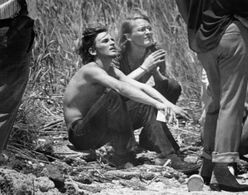
Henley (left) and Brooks (right) during a search party for Corll's victims.
In the winter of 1971, Brooks lured Elmer Wayne Henley as a new victim. For reasons unknown, Corll spared him, offered Henley the same fee of $200 for any boy he could lure to Corll's apartment, and told Henley that he was a member of a slavery ring. Henley ignored Corll's offer for several months, but he finally accepted it in early 1972, when Henley's family were in dire financial circumstances. On March 24, 1972, the trio encountered an acquaintance of Henley's, Frank Aguirre, when he was leaving a restaurant. They convinced Aguirre to come to Corll's apartment with the promise of drinking beer and smoking marijuana. There, Corll pushed him onto the table and handcuffed him. When he saw it, Henley attempted to persuade Corll to not hurt Aguirre; instead, he killed him, then revealed that there was no human slavery ring and that he had also raped and murdered the previous boy that Henley had lured for him. Henley then followed Corll's instructions and buried Aguirre's body in High Island Beach. However, according to Brooks, Henley was a sadistic individual who enjoyed murdering boys on his own.
Death[]
"Y'all better come here right now! I just killed a man!"
-Elmer Wayne Henley
The murder spree continued until August 7, 1973. Henley, now aged seventeen, invited Timothy Kerley to attend a party at Corll's house. Kerley accepted the offer, but as they were heading there, they were joined by Rhonda Williams, a friend of Kerley's. Williams' father was drunk and he attacked her that evening, so she decided to wait outside until he sobered up. Henley took pity of Williams and invited her to Corll's home. Corll was initially furious about Henley bringing a girl to his house but later calmed down after Henley told him about Williams' father and how she could not return home, and he offered the trio beer and marijuana. They drank and smoke while Corll watched and waited for them to pass out. Henley awoke to find himself gagged while Corll snapped handcuffs onto his wrists; the still-unconscious Williams and Kerley were strapped next to him in the same manner. Noticing that Henley was awake, Corll removed the gag and said that he was going to kill them all because of Williams. Henley then promised to Corll that he would participate in the torture and murder of both Kerley and Williams if Corll released him, to which he agreed.
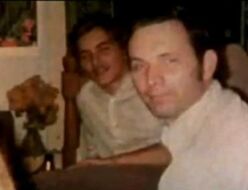
A rare photograph of Corll and Henley together.
The two dragged Kerley and Williams to Corll's bedroom and strapped them to the board. Corll handed Henley a hunting knife and told him to cut Williams' clothes, insisting that he rape and kill Williams entirely by himself, while he was occupied with Kerley. By this point, both Kerley and Williams had awoken. Henley removed Williams' gag and began to cut her clothes, prompting her to ask, "Is this for real?" When Henley said "Yes", Williams asked him, "Are you going to do anything about it?" This caused Henley to question his actions under Corll's orders for the first time. He first asked Corll if he could take Williams to another room, but he ignored him. Henley then grabbed Corll's pistol and shouted that they had gone too far and they had to stop. Corll left Kerley and yelled at Henley to kill him. Panicking, Henley stepped back as Corll advanced and taunted him, saying, "You won't do it!" Henley then fired once at Corll, hitting him in the forehead, but the bullet failed to penetrate his skull. Corll continued to lurch towards Henley and he fired two more shots, hitting Corll in the left shoulder. Corll then spun around and exited the room, hitting the wall of the hallway. Henley followed him and fired three more times into his back, killing him.
Henley freed Kerley and Williams and they discussed what to do. Henley just wanted to leave, but Kerley convinced him to call the police and explain what happened. Once in custody, Henley confessed to Brooks' and his own involvement in Corll's murders, and revealed the locations where the bodies had been buried. The police used unqualified convict labor to dig up the bodies, and the search was abruptly ended when their body count just surpassed 25, the number of victims attributed to Juan Corona, who was considered the most prolific American serial killer up to that point. As a result, the total number of Corll's victims remains unknown, and some of his attributed 29 victims were known only from spare bones that did not match any retrieved bodies. Henley was later indicted for and found guilty of six murders. Brooks, who attempted to portray himself as a silent partner of Corll and Henley's who was not present for any rapes and murders, was indicted for four murders and found guilty of one. Both accomplices were sentenced to life in prison.
Henley is currently incarcerated at the Mark W. Michael Unit in Anderson County, Texas, while Brooks was incarcerated at the Ramsey Unit near Rosharon. He later died on May 28, 2020 from COVID-19, aged 65
Modus Operandi[]
Corll targeted males between the ages of 13 and 20, all of whom he would abduct with the help of Brooks and Henley. His victims were either friends of Henley and/or Brooks, acquainted with Corll, or former employees of the Corll Candy Company. Corll would drive them to his house with promises of alcohol or drugs, and once there, they would be stripped naked and tied to a plywood torture board in Corll's bedroom. They were then raped, beaten, and tortured through various means (including rape, sodomy, plucking out their pubic hairs, chewing on their genitals, inserting various objects into their rectums, and putting glass rods in their urethras and smashing them), sometimes for several days. When he killed his victims, Corll would usually strangle them or shoot them with a .22-caliber pistol. However, in the case of Jeffrey Konen, he was asphyxiated with a piece of cloth. The bodies were then tied in plastic sheets and buried in one of three mass graves: beneath Corll's boatshed in Southwest Houston, near Lake Sam Rayburn, and in High Island Beach. Occasionally, Corll would force his victims to either call or write letters to their parents explaining their absence, helping the Houston Police Department's assumption that the victims were runaways. He also kept their keys as trophies.
Known Victims[]
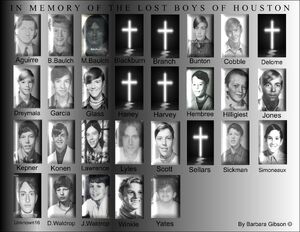
Known fatal victims of Corll.
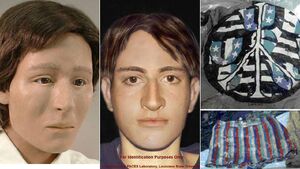
Composites and clothing closeups of "Swimsuit Boy", the only victim in the boat shed who is still unidentified.
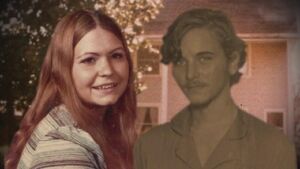
Attempted victims Rhonda Williams and Timothy Kerley.
- Early 1969: David Owen Brooks, 14 (his first accomplice; paid for oral sodomy)
- 1970:
- September 25: Jeffrey Konen, 18 (strangled and asphyxiated with a cloth gag; buried at High Island Beach)
- December 13: James Glass and Danny Yates (both raped, strangled with a cord and buried in the boat shed):
- James Glass, 14
- Danny Yates, 14
- 1971:
- January 30: Donald Waldrop and his brother Jerry (both raped, tortured, strangled, and buried in the boat shed):
- Donald Waldrop, 15
- Jerry Waldrop, 14
- Between January 30 and March 9: Elmer Wayne Henley, 14 (his second accomplice; attempted; was spared and recruited into the crimes)
- March 9: Randell Harvey, 15 (raped, shot in the head, and buried in the boat shed; identified in 2008)
- May 29: David Hilligiest and Gregory Winkle (both raped, strangled with a cord, and buried in the boat shed):
- David Hilligiest, 13
- Gregory Malley Winkle, 16
- August 17: Ruben Watson Haney, 17 (raped, strangled, and buried in the boat shed)
- January 30: Donald Waldrop and his brother Jerry (both raped, tortured, strangled, and buried in the boat shed):
- Unspecified date in 1971 or 1972: "Swimsuit Boy", 15-19 (unidentified; buried in the boat shed; his body was found on August 9, 1973)
- 1972:
- February 9: William Branch, Jr. 17 (emasculated, strangled, and buried in the boat shed; identified in 1985)
- March 24: Frank Aguirre, 18 (Henley's friend and Williams' fiancé; strangled and buried at High Island Beach)
- April 20: Mark Scott, 17 (strangled and buried at High Island; his body was not recovered)
- May 21: Johnny Delome and Billy Baulch, Jr. (both raped, strangled, and buried at High Island):
- Johnny Delome, 16 (also shot in the head)
- Billy Baulch, Jr., 17
- July 19: Steven Sickman, 17 (bludgeoned with an unspecified object, cracking several ribs, and fatally strangled with a nylon cord; buried at High Island; misidentified in 1993 and correctly identified in 2011)
- August 21: Roy Bunton, 19 (was gagged with a section of a Turkish towel and mouth bound with adhesive tape, then shot twice in the head and buried in the boat shed; misidentified in 1973, then correctly identified in 2011)
- October 2: Wally Simoneaux and Richard Hembree (both raped and strangled):
- Wally Jay Simoneaux, 14 (buried in the boat shed)
- Richard Hembree, 13 (also shot in the mouth; buried in an unknown location)
- November 12: Richard Kepner, 19 (raped, strangled, and buried at High Island; identified in 1983)
- 1973:
- February 1: Joseph Lyles, 17 (strangled and buried at Jefferson County Beach; found in 1983 and identified in 2009)
- June 4: William Ray Lawrence, 15 (kept alive for three days; raped, strangled with a cord, and buried at Lake Sam Rayburn)
- June 15: Raymond Blackburn, 20 (strangled and buried at Lake Sam Rayburn)
- July 7: Homer Garcia, 15 (shot in the head and chest and left to die of exsanguination in Corll's bathtub; buried at Lake Sam Rayburn)
- July 12: John Sellars, 17 (shot four times in the chest and buried at High Island Beach)
- July 19: Michael Baulch, 15 (Billy Baulch's brother; raped, strangled, and buried at Lake Sam Rayburn; identified in 2010)
- July 25: Marty Jones and Charles Cobble (both shot and buried in the boat shed):
- Marty Jones, 18
- Charles Cary Cobble, 17
- August 3: James Stanton Dreymala, 13 (raped, strangled, and buried in the boat shed)
- August 8: The standoff at Corll's house:
- Timothy Cordell Kerley, 19 (attempted to rape and shoot; was rescued; died of an acute myocardial infarction years later)
- Rhonda Williams, 15 (intended to rape and kill by proxy; was rescued)
- Elmer Wayne Henley, 17 (his accomplice; intended to kill)
- Note: William Branch, Jr.'s father, William Branch, Sr., was a Houston police officer who died of a heart attack while searching for his son. As a result, he had been, at times, considered an indirect victim of Corll.
Evidence of Other Victims
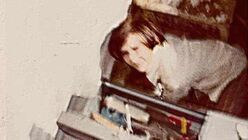
A partial Polaroid possibly showing another unidentified victim of Corll.
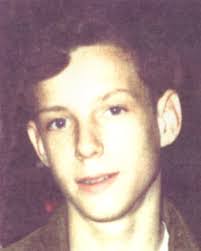
Norman Lamar Prater.
- A total of 44 boys were reported missing in Houston during the period of Corll's known activity.
- An isolated arm bone and pelvis were found in the same grave containing the 26th and 27th victims, who had been buried tied together. The search was abruptly terminated shortly after finding them, in spite of Henley's claim that Mark Scott and Joseph Lyles had not been found yet. Lyles' body was found by chance in 1983, and Scott's body has yet to be found. However, the bones have not been positively matched to Scott, and Henley denies that Scott was buried there, implying the existence of a 30th victim.
- Corll Candy Company employees saw Corll retrieving nylon cords and plastic rolls, which resembled those used to bury the bodies, from the factory as early as 1968. He also dug a lot in those years, supposedly to bury spoiled candy.
- Brooks declared that the two youths he saw when he ran into Corll and was bribed into silence were not James Glass and Danny Yates, Corll's first known instance of a double homicide. He also said that Corll had killed another victim before their first encounter, and that it happened at Corll's earlier residence before he moved into the house where Brooks and Henley brought victims to him.
- Corll, Henley, and Brooks were suspects in the January 17, 1973, disappearance of sixteen-year-old Norman Lamar Prater. Prater was last seen in Dallas, Texas, accompanied by a man and two teenagers with long hair; he lived in the same neighborhood as most of Corll's victims, went to the same high school as Henley between 1970 and 1971, and continued to visit Houston during weekends after he moved to Dallas. There are no known murders attributed to Corll between November 1972 and February 1973, but he is believed to have continued killing during that time.
- In March 1973, a couple announced seeing three men burying a suspiciously long, wrapped bundle in Galveston County. That same couple identified two of the men as Corll and Henley, and said that the third had long, blond hair like Brooks. However, there are no known murders attributed to Corll between February and June 1973, and no bodies were searched in Galveston.
- Two other witnesses also claimed to have seen three suspicious men digging at the beach in May 1973, one of whom was later identified as Brooks. This sighting was not investigated by the Houston Police Department.
- An unrelated March 1975 investigation discovered a cache of pornographic pictures and films of sixteen young boys in Houston. Eleven of these boys were identified as Corll's then-known victims, giving rise to the possibility that he was telling Henley the truth when he said that he was part of a slavery ring "that bought and sold boys". Subsequent investigations resulted in the arrest of five individuals in Santa Clara, California. However, the Houston Police Department declined to investigate any links between them and Corll, arguing that Corll's victims' families "had already suffered enough". According to Brooks, Corll told him once that his first victims had been buried in California.
- In February 2012, a filmmaker preparing a documentary about Henley found a partial Polaroid among the objects of Henley that his family had stored after his arrest in 1973. The image purportedly shows an unidentified boy in handcuffs, strapped to an unseen device on the ground, and next to Corll's toolbox. The boy has not been matched to any known victim of Corll and Henley claims to not know his identity. However, he has confirmed that he bought a Polaroid camera in 1972, the same year he met Corll.
Notes[]
- Corll remained the most prolific known serial killer in the U.S. until 1978, when Ted Bundy and John Wayne Gacy were both each attributed over 30 murders. Gacy reportedly admired Corll and was inspired to build his homemade "rack" after reading on the Houston Mass Murders. In 2012, allegations surfaced linking Gacy to a human trafficking ring, much like Corll had been rumored decades earlier.
On Criminal Minds[]
While Corll was never directly mentioned or referenced on the show, he appears to have been an inspiration for the following unsubs:
- Season Five
- Bill Jarvis ("Haunted") - Both were serial killers and abductors who lost their businesses (a mechanic shop in Jarvis's case, a family candy company in Corll's), targeted adolescent boys, had at least one younger accomplice (at least one of whom they abused) who helped them lure their victims into their vehicles to abduct them, would hold them captive for days at a time and torture them, disposed of their bodies by burying them, held more than one victim captive at least once, were active in the 1970s and went undetected for years, were given nicknames for their crimes, and were ultimately shot dead by their accomplice before they could be arrested.
- Anita Roycewood ("Mosley Lane") - Both were serial killers and abductors who used two submissive male accomplices to abduct victims (one of whom was an abducted victim himself). And both were ultimately betrayed and shot to death by said accomplices while they were attempting to kill another victim. It's also interesting to note that Anita's husband being an electrician might be another nod to Corll, who worked as an electrician at the time of his death.
- Season Six
- Lee Mullens ("Remembrance of Things Past") - Both were serial killers who were considered good and respected people, had medical conditions (Corll had rheumatic fever, while Mullens later developed Alzheimer's), had jobs as electricians, targeted a specific young gender (males 13-20 in Corll's case, females in their 20s in Mullens'), had at least one younger accomplice who they dominated, abducted their victims in vans using ruses, took them to their homes where they would be tied to a flat surface (a 'torture board' in Corll's case, a table in Mullens'), then be tortured through sodomy and with sharp implements, had their victims contact their loved ones before their deaths (though for different purposes; Corll sometimes had his victims write to or call their loved ones in order to have them be reported as runaways, while Mullens had his victims call their families in order to tell them goodbye and that they "enjoyed it"), disposed of their bodies outdoors in mass graves near their house, killed over (at least in Mullens' case) two dozen victims, and were given nicknames. Also the way Bachner was stopped while attempting to kill Anna and Mullens ultimately giving away his whereabouts is somewhat similar to how Corll and Henley ultimately turned on each other after the latter brought Rhonda Williams to the former (a victim he disapproved of).
- Season Eight
- David Turner and Toby Whitewood ("The Apprenticeship") - Both teams consisted of serial killers (budding at least) and abductors, with the dominant partner (Corll and Turner) being an ephebophilic, and homosexual killer in his 30s (though Turner might have been bisexual instead) mentored a fifteen-year-old boy, whom they were sexually attracted to (Henley and Whitewood, respectively), in serial killing. They also used them to lure new victims for themselves. Subsequently, in both partnerships, the boy disobeyed the adult's advice and brought a victim that didn't fit the preferences of the adult, causing a confrontation and the eventual murder of one member by the other (though it was the adult who died in Corll and Henley's case, and the boy in Turner and Whitewood's). Also, like Corll, Turner revealed that he had plans to murder both the chosen victim and his own pupil, and was willing to be shot when someone pointed a gun at him and demanded that he release the victim. In addition, the confrontation between Turner and Whitewood took place in a boat shed, while Corll and Henley buried most of their mutual victims in one.
